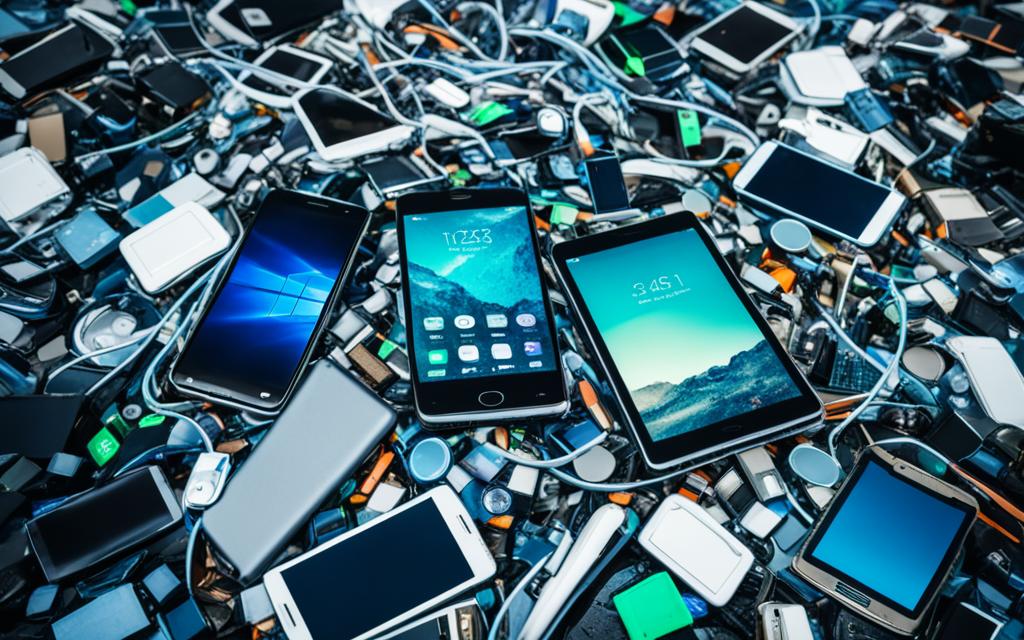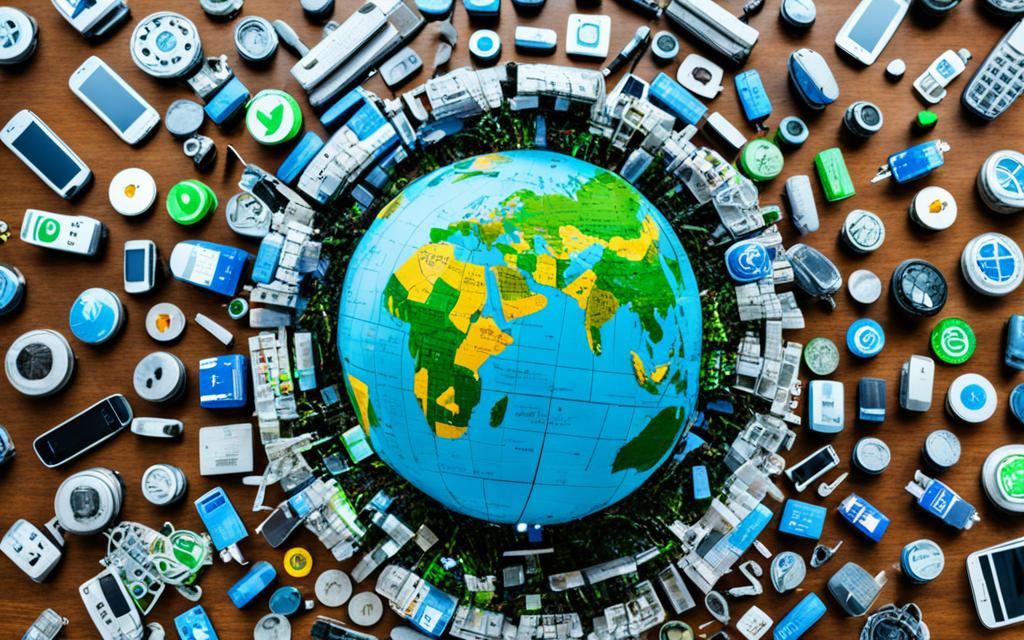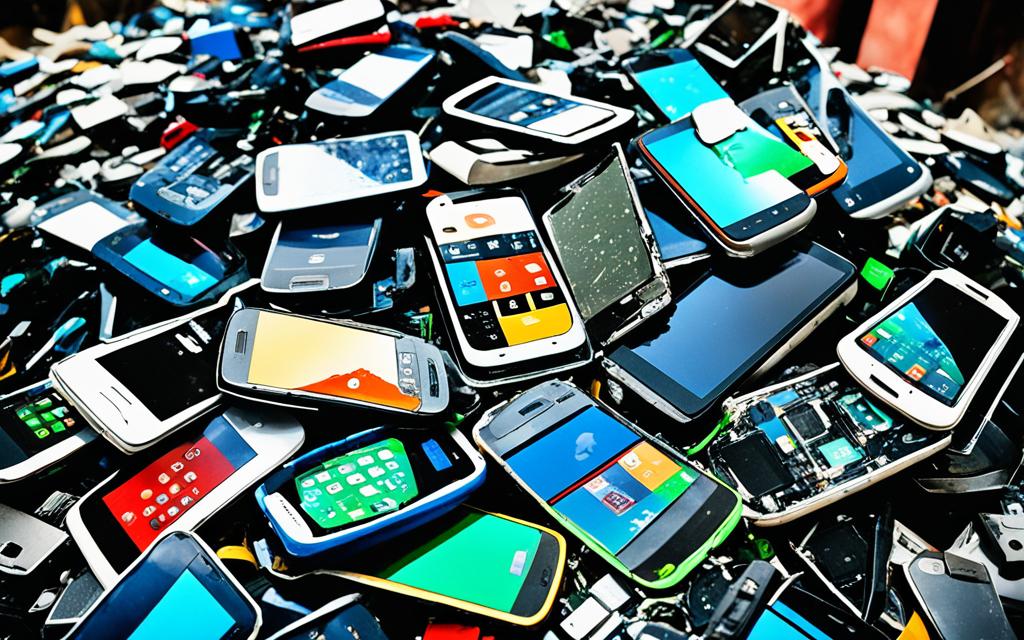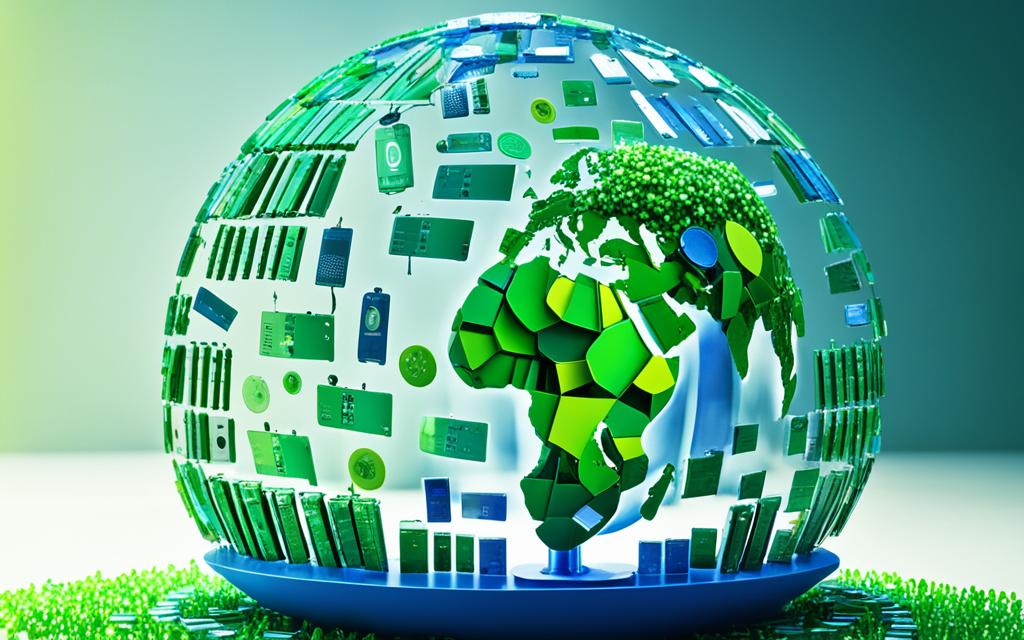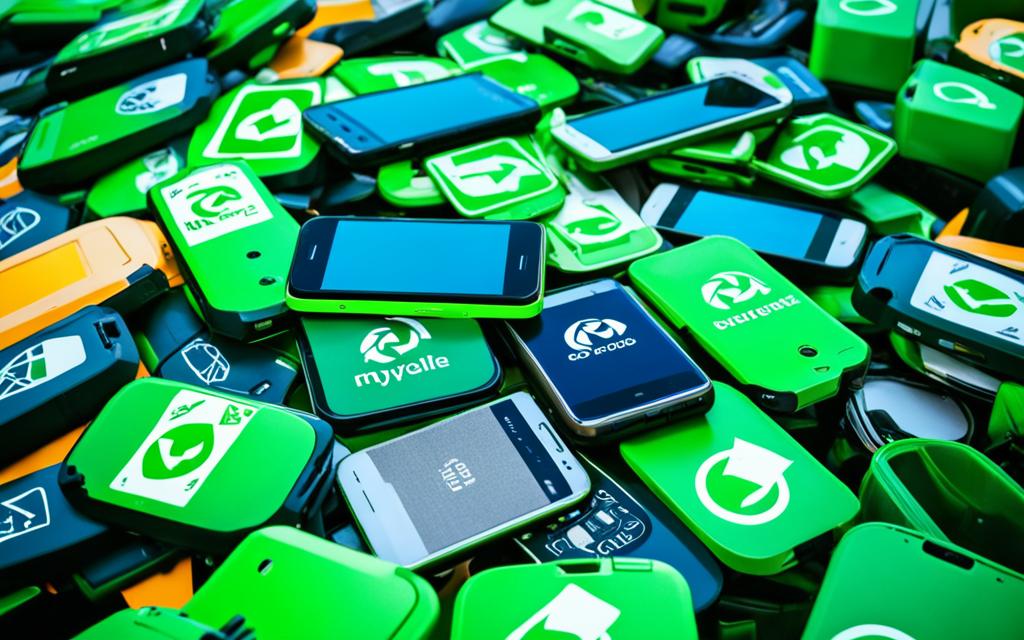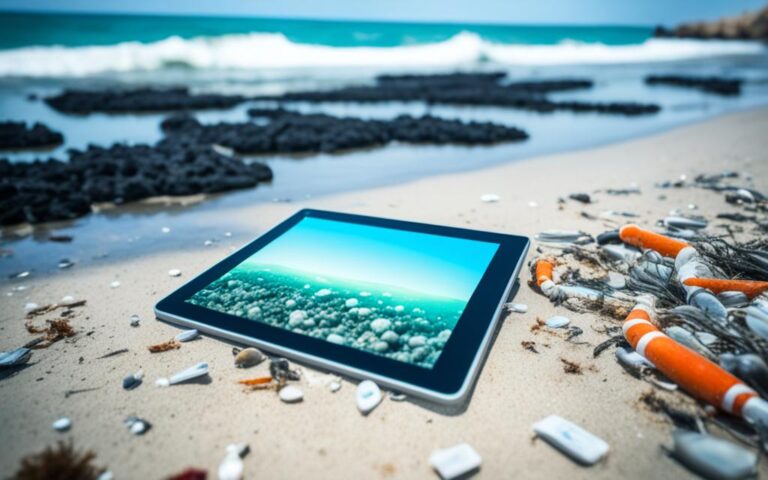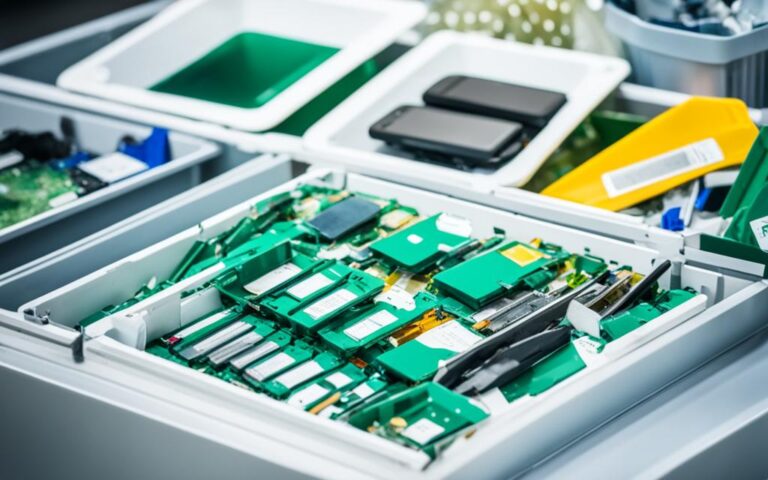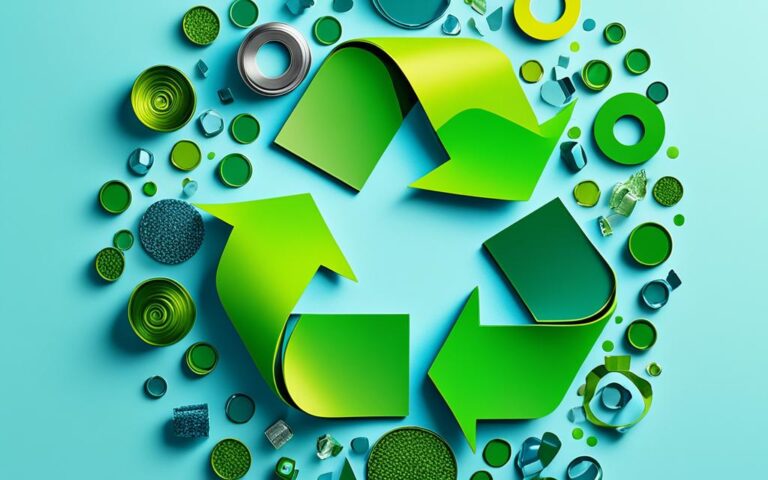The Environmental and Social Impact of Phone and Tablet Recycling
Did you know that your old mobile phone or tablet could be causing significant harm to the environment and the ecosystem? The production and disposal of these devices have a far-reaching impact on our planet, from depleting precious natural resources to contributing to greenhouse emissions.
When we buy a new phone or tablet, we often discard the old ones without considering the consequences. This results in a staggering amount of electronic waste that ends up in landfills, releasing toxic substances into the environment. Additionally, the manufacturing process of these devices consumes vast amounts of energy, further contributing to carbon emissions.
It’s time to take action and make a positive change. By recycling our mobile phones and tablets, we can significantly reduce our environmental footprint. Recycling not only conserves valuable materials like gold and lithium but also minimizes the release of hazardous substances into the environment.
Furthermore, recycling helps to save energy. Did you know that recycling just one phone can save enough energy to charge a laptop for about 44 hours? By extending the lifespan of our devices through recycling and reducing e-waste, we are actively contributing to a more sustainable future.
Join the movement for a greener planet. Let’s make a conscious effort to recycle our old mobile phones and tablets, reducing electronic waste and preserving our environment for future generations. Together, we can make a difference.
Carbon Footprint and Emissions from Smartphones and Tablets
The production and usage of smartphones and tablets contribute significantly to carbon emissions and environmental damage. The manufacturing process of smartphones involves the extraction of valuable resources and the release of a substantial amount of energy, resulting in higher carbon emissions. Additionally, data centres and information communication technology (ICT) infrastructure also contribute to increased carbon footprints.
According to Deloitte, smartphones alone are predicted to generate 146 million tons of CO2e emissions in 2022. These emissions are primarily caused by the manufacturing process, which involves mining, refining, and assembling the components that make up the devices. The carbon emissions further increase when considering the energy consumed during the use phase and the disposal of outdated devices.
The Environmental Impact of Smartphone and Tablet Production
- The manufacturing process of smartphones and tablets requires the extraction of raw materials, such as rare earth metals, which are often mined through environmentally damaging practices.
- The energy-intensive production process, including the assembly of components and the manufacturing of circuit boards, results in higher carbon emissions.
- The disposal of electronic waste from outdated devices also contributes to environmental pollution and increased carbon footprint.
In addition to the direct impact of device production, data centres and ICT infrastructure play a significant role in carbon emissions. These facilities require substantial energy consumption to power and cool the servers that store and process data.
Recycling and reducing e-waste can significantly lower greenhouse emissions associated with smartphones and tablets, mitigating their environmental impact.
By recycling electronic devices, including smartphones and tablets, valuable materials can be recovered and reused, reducing the need for resource-intensive mining and manufacturing processes. Furthermore, recycling prevents hazardous materials from being released into the environment, mitigating pollution and associated environmental damage.
It is important for individuals and businesses to prioritize recycling and proper disposal of electronic devices to minimize their carbon footprint and contribute to a more sustainable future.
Importance of Recycling and Recovering Electronic Devices
Proper disposal of electronic devices is crucial to prevent environmental pollution. When mobile phones and gadgets are thrown in the trash, their components can be recovered and recycled instead. These devices continuously contribute to the greenhouse effect and contaminate the land. Recycling electronic devices helps conserve the environment by reusing valuable materials and minimizing the release of hazardous substances. It is essential to raise awareness about the effects of electronic waste on the ecosystem.
By recycling electronic devices, we not only reduce the burden on our planet but also recover valuable resources. These devices contain various precious metals like gold, silver, and copper, which can be extracted and reused instead of mining for new materials. In addition, recycling helps reduce the demand for energy-intensive manufacturing processes that contribute to carbon emissions and climate change.
Recycling electronic waste plays a crucial role in minimizing the release of hazardous substances into the environment. Many electronic devices contain toxic components such as lead, mercury, cadmium, and flame retardants. When these substances end up in landfills, they can contaminate soil, water sources, and even enter the food chain, posing health risks to both humans and wildlife. By recycling these devices, we prevent the release of these harmful substances and protect the ecosystem.
Visual representation of the importance of recycling electronic devices.
The Benefits of Recycling and Recovering Electronic Devices:
- Conserves natural resources by reusing valuable materials
- Reduces the demand for energy-intensive manufacturing processes
- Minimizes greenhouse gas emissions associated with production
- Prevents the release of hazardous substances into the environment
- Reduces the need for mining and extraction of new resources
- Helps create a circular economy by promoting resource efficiency
- Supports the development of recycling technologies and innovation
- Contributes to a more sustainable and environmentally conscious society
Quoting Experts in the Field:
“Recycling electronic devices is not just about reducing waste; it’s about protecting our natural resources and preserving the environment for future generations. By recovering valuable materials and minimizing the release of hazardous substances, we can create a more sustainable world.” – Dr. Sarah Thompson, Environmental Scientist
| Impact of Recycling Electronic Devices | Benefit |
|---|---|
| Conserves natural resources | Reduces the need for resource extraction |
| Reduces greenhouse gas emissions | Minimizes the carbon footprint of manufacturing |
| Prevents soil and water contamination | Protects ecosystems and wildlife |
| Promotes resource efficiency | Creates a circular economy |
By recycling and recovering electronic devices, we can make a significant impact on the environment and create a more sustainable future. It is crucial for individuals, businesses, and governments to prioritize electronic waste management and take proactive steps towards recycling and recovery.
The Environmental Impact of Mobile Phone Discarding
In today’s digital age, mobile phones have become an integral part of our lives. Unfortunately, the constant disposal of these devices has led to a significant environmental impact, specifically in the form of electronic waste. Every year, millions of mobile phones are discarded, contributing to pollution and the contamination of air and water.
Electronic waste contains hazardous materials such as lead, mercury, arsenic, cadmium, and flame retardants. When these toxic metals are released into the environment, they can contaminate ecosystems and pose serious health risks to both humans and animals. The improper disposal of mobile phones not only harms the environment but also threatens the well-being of living organisms.
Recycling mobile phones is an effective solution to mitigate the environmental impact of discarding these devices. By recycling, valuable materials can be recovered and reused, reducing the need for raw resource extraction. Additionally, recycling prevents the release of harmful substances into the environment, promoting a cleaner and healthier planet for future generations.
“The improper disposal of mobile phones not only harms the environment but also threatens the well-being of living organisms.”
By raising awareness about the importance of proper mobile phone recycling, we can all contribute to reducing electronic waste and its detrimental effects on our planet. Recycling bins for mobile phones can be placed in various locations, such as shopping centers, electronics stores, and community centers, making it convenient for individuals to dispose of their old devices responsibly.
It is crucial for individuals, manufacturers, and policymakers to prioritize the recycling of mobile phones and take collective action to address the environmental impact of electronic waste. Together, we can make a significant difference in preserving the environment and creating a sustainable future.
Benefits of Recycling Mobile Phones and Tablets
Recycling mobile phones and tablets offer numerous benefits. It is an effective approach to reducing electronic waste and its impact on the environment. By choosing to recycle these devices instead of discarding them, we can contribute to a sustainable future and reap the following advantages:
- Conservation of the environment: Recycling helps prevent the release of hazardous materials like lead and mercury into the environment. These substances can contaminate ecosystems, posing risks to both wildlife and human health. By responsibly recycling mobile phones and tablets, we can reduce the negative impact on our planet.
- Energy savings: Did you know that recycling just one phone can save enough energy to charge a laptop for about 44 hours? By recovering and reusing valuable materials, recycling reduces the need for energy-intensive processes involved in mining and manufacturing new devices. This not only conserves energy but also helps lower greenhouse gas emissions.
- Reduced resource depletion: Mobile phones and tablets contain precious minerals like copper, silver, gold, and palladium. These minerals are finite resources and mining them has a significant environmental impact. By recycling these devices, we can reduce the demand for new mining activities, preserving these valuable resources and minimizing the destruction of ecosystems caused by mining operations.
Let’s take a closer look at the benefits of recycling mobile phones and tablets through the following table:
| Benefit | Description |
|---|---|
| Conservation of Environment | Prevents the release of hazardous materials and minimizes environmental contamination. |
| Energy Savings | Recycling saves energy by reusing materials, reducing the need for energy-intensive mining and manufacturing processes. |
| Reduced Resource Depletion | By recycling, we can reduce the demand for new mining activities, ensuring the conservation of valuable minerals. |
By embracing recycling practices for mobile phones and tablets, we can make a significant positive impact on our environment and create a more sustainable future for generations to come.
Extending the Lifespan of Smartphones and Tablets
Extending the lifespan of smartphones and tablets is essential to reduce their environmental impact. By improving durability and software support, manufacturers are making these devices tougher and more resistant to damage from drops and water. Additionally, longer software support and regular updates enable devices to be used for a longer period, reducing the need for frequent replacements.
By promoting prolonged ownership and reducing the number of devices manufactured, the carbon footprint of smartphones and tablets can be significantly reduced. When users hold onto their devices for a longer time, fewer resources and energy are required for production, resulting in a more sustainable approach to technology consumption.
Moreover, by embracing repairability and facilitating easy access to replacement parts, manufacturers can empower users to extend the lifespan of their smartphones and tablets. This shift towards user-centric design encourages device owners to repair and upgrade their devices instead of discarding them.
Emphasizing the importance of repairs, Apple launched the Independent Repair Provider program, enabling independent repair shops to access genuine Apple parts and resources. This initiative promotes a circular economy by providing quality repair options to consumers and reducing electronic waste.
Key Strategies for Extending Smartphone and Tablet Lifespan
- Improved durability: Manufacturers can focus on creating devices that are resistant to physical damage, such as reinforced frames and water-resistant designs.
- Software support: Continued software updates ensure devices remain compatible with the latest applications and security patches, extending their usefulness over time.
- Repairability: Simplified access to replacement parts and repair guides empowers users to fix minor issues and extend the lifespan of their devices.
- Modularity: Designing devices with modular components allows for easy upgrading and replacement of individual parts, reducing the need for full device replacements.
- Education and awareness: Providing consumers with information on the benefits of extending device lifespan encourages responsible ownership and sustainable technology use.
Environmental Impact of Extending Device Lifespan
Extending the lifespan of smartphones and tablets has a measurable positive impact on the environment. By reducing the frequency of device replacements, the following environmental benefits can be achieved:
| Environmental Benefit | Description |
|---|---|
| Reduction in greenhouse gas emissions | Longer device lifespan decreases the carbon emissions associated with manufacturing, transportation, and disposal of electronic devices. |
| Conservation of resources | Extended lifespan reduces the demand for raw materials, including rare earth elements, resulting in reduced mining activities and preservation of natural resources. |
| Decreased electronic waste | When devices are used for a longer period, the amount of electronic waste generated decreases, minimizing the environmental hazards posed by improper e-waste disposal. |
Changing the Smartphone Industry for Sustainability
The smartphone industry has the potential to revolutionize its practices and pave the way for a more sustainable future. By embracing sustainable approaches, manufacturers can create higher-priced devices that prioritize both performance and environmental responsibility.
One way manufacturers can contribute to sustainability is by offering additional revenue streams through media services, online storage, and complementary hardware. This not only generates income but also encourages users to maximize the lifespan of their devices, reducing electronic waste.
Carriers, on the other hand, can play a crucial role by shifting their focus towards offering refurbished devices and ancillary services. By promoting the reuse of existing devices, carriers can extend their lifecycle and minimize the need for new phone production, which contributes to carbon emissions and resource depletion.
The smartphone industry has the opportunity to lead by example and set new standards for sustainability. By prioritizing green credentials and actively reducing carbon footprints, smartphone manufacturers and carriers can inspire other device categories to follow suit, creating a ripple effect throughout the industry.
Setting a New Standard
“The smartphone industry has the power to drive change and foster sustainability. By adopting eco-friendly practices, manufacturers and carriers can significantly reduce the environmental impact of smartphones and set an example for other industries. It’s time to prioritize sustainable innovation and create a future where smartphones not only enhance our lives but also protect the planet.” – Environmental Expert
Through sustainable practices, the smartphone industry can contribute to overall emissions reductions and environmental preservation. By embracing sustainability, manufacturers can not only improve their brand reputation but also appeal to conscious consumers who prioritize ethical and environmentally responsible products.
Sustainability Initiatives in the Smartphone Industry
| Initiative | Description |
|---|---|
| Design for longevity | Manufacture devices with improved durability and modular components for easy repairs and upgrades. |
| Recycling programs | Establish comprehensive recycling programs to ensure the proper disposal and reuse of electronic waste. |
| Renewable energy | Transition to using renewable energy sources in manufacturing processes and operations. |
| Reduced packaging | Optimize packaging materials and design to minimize waste and environmental impact. |
| Transparency | Provide clear information about a device’s environmental impact, including carbon emissions and resource usage. |
The smartphone industry has the potential to drive positive change and champion sustainability. Through collective efforts and innovative strategies, manufacturers and carriers can reshape the industry’s landscape, ensuring that future generations can enjoy the benefits of advanced technology without compromising the health of our planet.
Conclusion
Recycling mobile phones and tablets is crucial for reducing the environmental and social impact of these devices. The production, usage, and disposal of smartphones and tablets contribute to carbon emissions, electronic waste, and resource depletion. However, by recycling these devices, we can make a significant difference in preserving the environment, conserving valuable resources, and preventing the release of hazardous materials.
Extending the lifespan of smartphones and tablets is another important aspect of mitigating their environmental impact. By promoting durability and providing long-term software support, manufacturers can encourage users to keep their devices for longer, reducing the overall number of devices manufactured and the carbon footprint associated with their production.
Furthermore, it is crucial for the smartphone industry to adopt a more sustainable approach. By prioritizing green credentials, offering refurbished devices, and exploring alternative revenue streams, manufacturers and carriers can contribute to a more sustainable future. This not only sets an example for other device categories but also helps in reducing overall carbon emissions.
In conclusion, recycling mobile phones and tablets, extending their lifespan, and fostering sustainability in the smartphone industry are essential steps towards minimizing the environmental and social impact of these devices. It is important for individuals, industries, and society as a whole to prioritize recycling and take collective action for a more sustainable and eco-friendly future.
FAQ
What is the environmental and social impact of phone and tablet recycling?
Phone and tablet recycling helps to reduce electronic waste, conserve valuable resources, save energy, and prevent the release of hazardous materials into the environment. It also contributes to a more sustainable future by reducing carbon emissions and minimizing the social impact of electronic waste.
How do smartphones and tablets contribute to carbon footprint and emissions?
The production and usage of smartphones and tablets result in higher carbon emissions due to the energy-intensive manufacturing process and the operation of data centers. Deloitte predicts that smartphones alone will generate 146 million tons of CO2e emissions in 2022.
Why is recycling and recovering electronic devices important?
Recycling and recovering electronic devices help conserve the environment by reusing valuable materials, minimizing the release of hazardous substances, and reducing greenhouse emissions. Proper disposal of electronic devices prevents environmental pollution and promotes the sustainable use of resources.
What is the environmental impact of mobile phone discarding?
Mobile phone discarding contributes to electronic waste, which causes pollution and contaminates air and water. Electronic waste contains hazardous materials like lead, mercury, arsenic, cadmium, and flame retardants, which can harm the environment and pose serious health risks to humans and animals.
What are the benefits of recycling mobile phones and tablets?
Recycling mobile phones and tablets helps conserve the environment by preventing the release of hazardous materials. It also saves energy, reduces the need for mining precious minerals, and effectively reduces electronic waste and its impact on the environment.
How can we extend the lifespan of smartphones and tablets?
The lifespan of smartphones and tablets can be extended through improved durability and software support. Manufacturers are making devices physically tougher and more resistant to damage. Longer software support and regular updates ensure devices can be used for a longer period, reducing the need for new devices and minimizing their environmental impact.
How can the smartphone industry contribute to sustainability?
The smartphone industry has the potential to achieve sustainability by creating higher-priced devices with sustainable approaches and offering additional revenue streams through media services, online storage, and complementary hardware. Carriers can also focus on offering refurbished devices and ancillary services instead of relying solely on the sale of new phones.
What is the conclusion regarding the environmental and social impact of phone and tablet recycling?
Phone and tablet recycling is vital for reducing the environmental and social impact of these devices. It helps conserve the environment, save energy, prevent the release of hazardous materials, and contribute to a more sustainable future. It is crucial for individuals and industries to prioritize recycling and take collective action for a greener and healthier planet.

